The Mahåbhårata is a unique text which not only claims for itself an encyclopaedic status declaring itself to be a compendium of everything that is there on social morality (dharma), political economy (artha), pleasure (kåma) and spiritual liberation (moksa) (Mbh I.56.33)—but also points out its rightful position as an itihåsa placed at a conversational crossroads among the authors located in its past, present and future (Mbh I.1.24; I.56.22). Therefore, there is no wonder that it captured the imagination of scholars, interpreters, translators and creative writers across time and space, leading to the production of a mammoth bibliography around itself. Sibaji Bandyopadhyay’s Three Essays on the Mahåbhårata is an addition to that corpus, and not a very novel one. All the three essays in the volume are pre-published in some form or other. The ‘exercises in literary hermeneutics’, the way the author introduces his work, is also not something completely new. The Mahåbhårata, though primarily considered an itihåsa text in ancient tradition, is often attributed other designations inside and outside the text, and the status of kåvya (creative literature), mahåkåvya (loosely translated as ‘epic’) and åkhyåna (narrative) have been among them. Therefore, if scholars like Christian Lassen, Adolf Holtzmann, Leopold von Schroeder, E. Washburn Hopkins and F.E. Pargiter had tried to see the text analytically to locate some ‘historical kernel’ by separating its layers, and a historicist approach—deployed by historians like Romila Thapar and R.S. Sharma—indicated a plausible separation between the narrative and the didactic sections of the text to unravel the ‘embedded history’ in it, there has been a strong tradition of hermeneutical studies viewing the text as a unified literary piece. The early medieval literary critics, Ånandavardhana and Abhinavagupta, found the literary essence of the diverse material of this massive text in the exposition of the sånta rasa (mood of tranquillity). Such an approach might not have been disapproved by the authoritative seventeenth century commentator on the text, Nilakantha. Since then, hermeneutical analysis of the Mahåbhårata has attracted many scholars including V.S. Sukthankar, A.K. Ramanujan, Patricia Greer and Radhavallabh Tripathi. If Stig Wikander and Georges Dumezil tried to locate the text within an overarching structure of Indo-European mythology, the overtly visible frame of Indian mythology has been asserted in the interpretations of Alf Hiltebeitel, Madeleine Biardeau and James Fitzgerald.
Yet, Bandyopadhyay’s work is a valuable contribution to this mammoth bibliography. The three essays he presents are not completely independent, but thematically linked. All three of them somehow address the Bhagavad Gitå, a much-discussed section of the ‘Bhiœmaparvan’ of the Mahåbhårata, which has not only gained a life of its own as an independent scripture, but has attracted all kinds of explanations of its location in its source text, from the status of the ‘central essence’ of the text to the dismissal as a later didactic interpolation. All the three essays address the issues of violence and nonviolence, as important today as in the time when the horrific carnage of the Bhårata War received its first bardic rendering. Most importantly, all three essays deal with the afterlife of the text.
Continue reading this review

